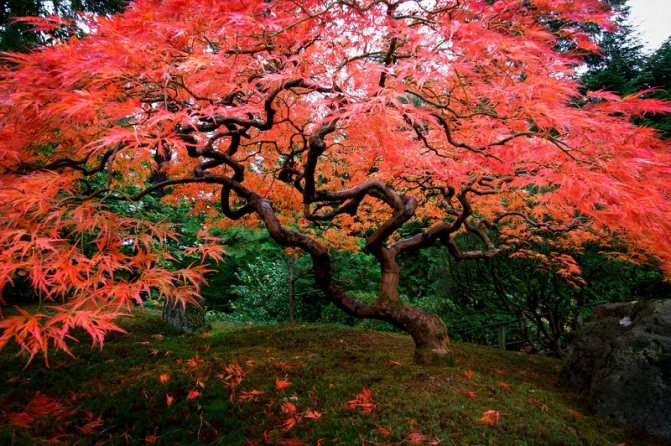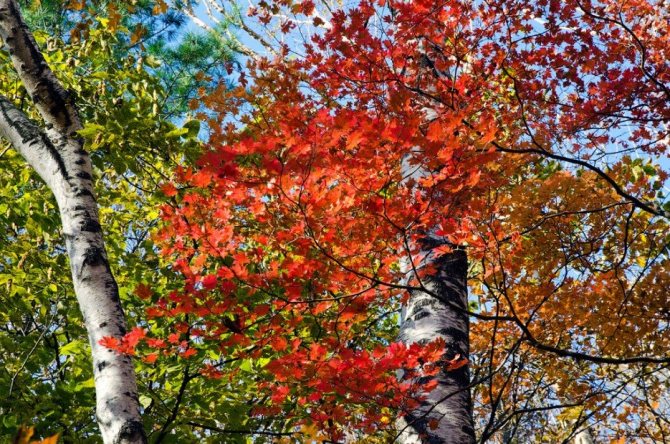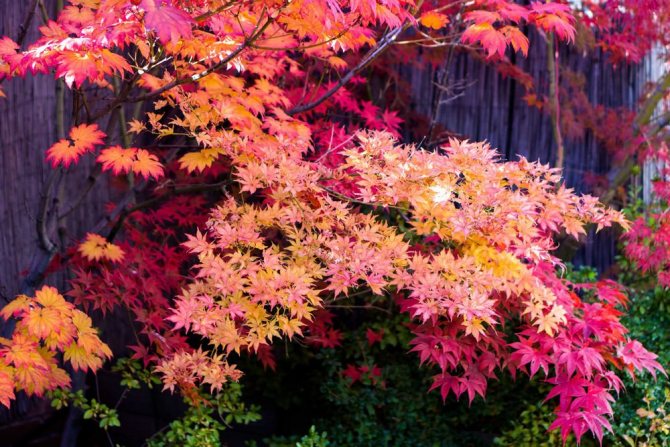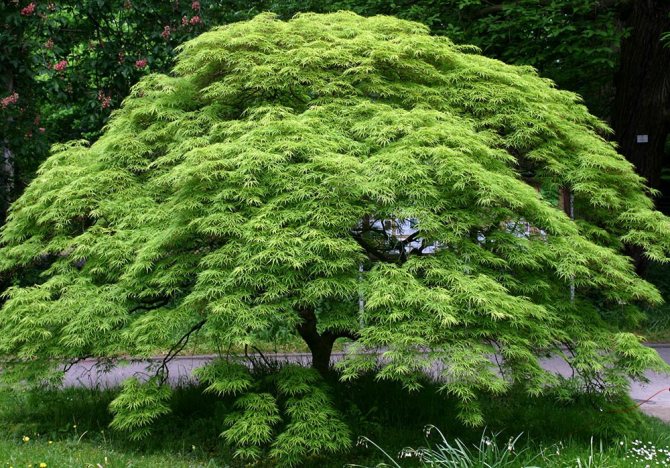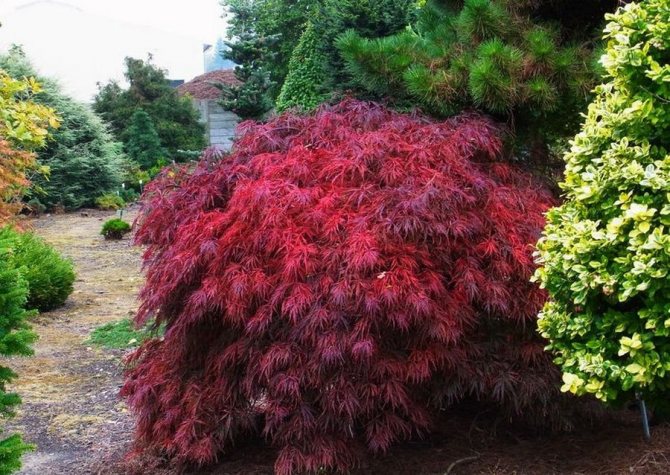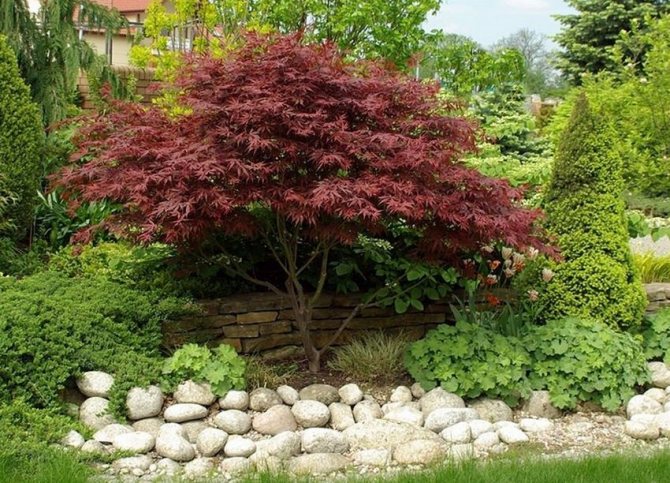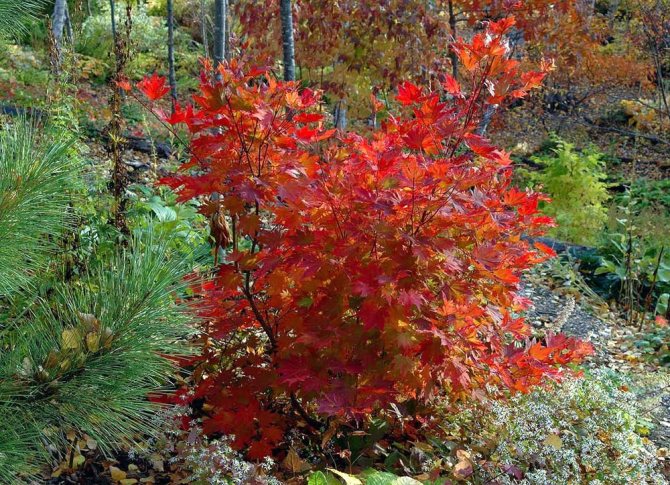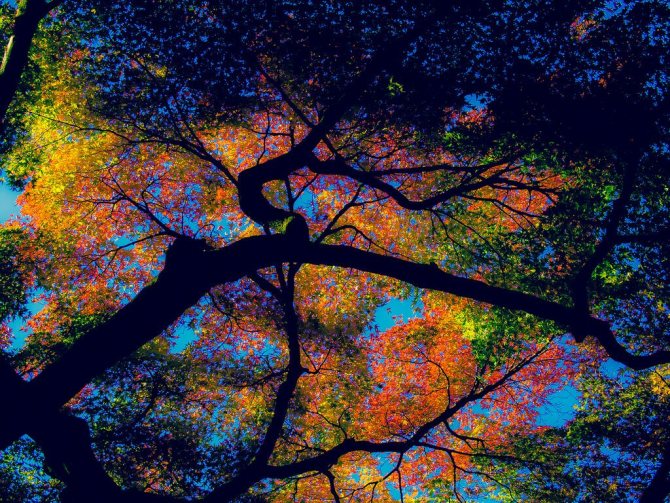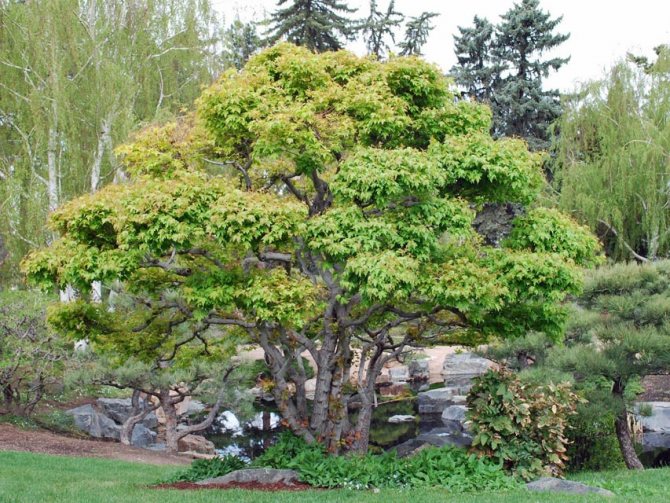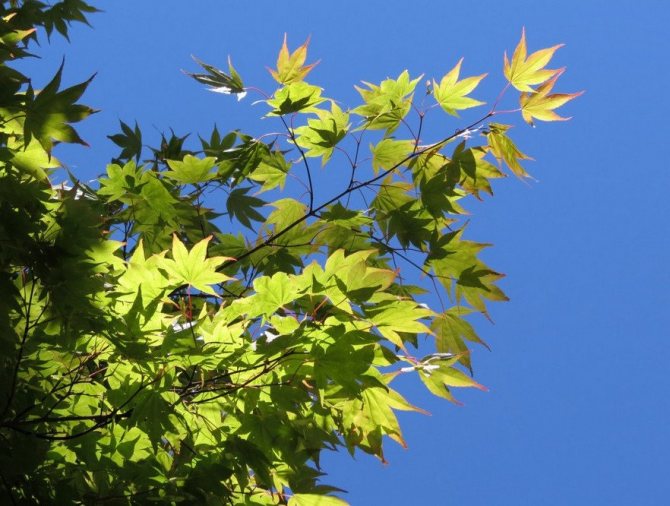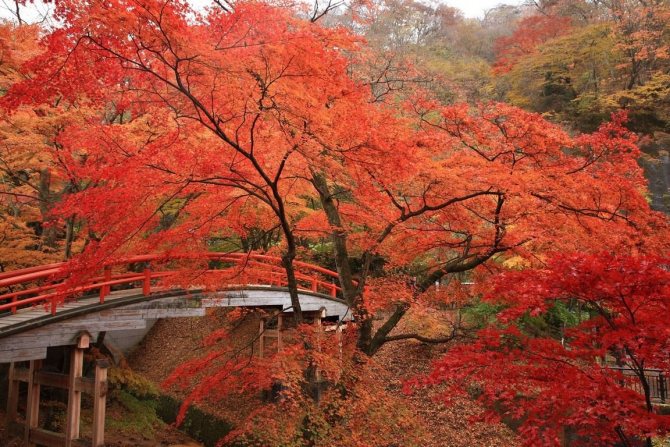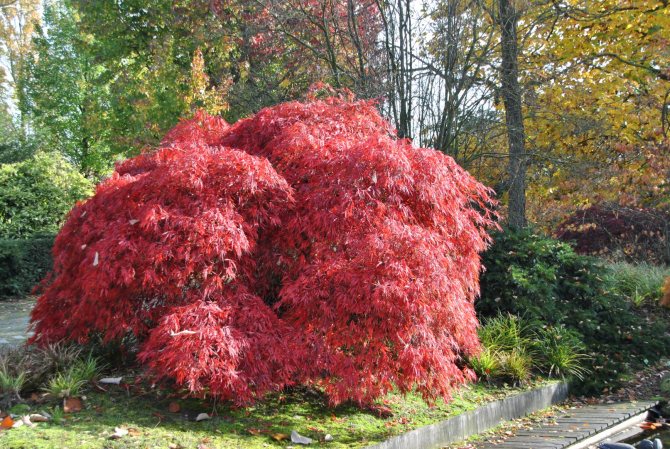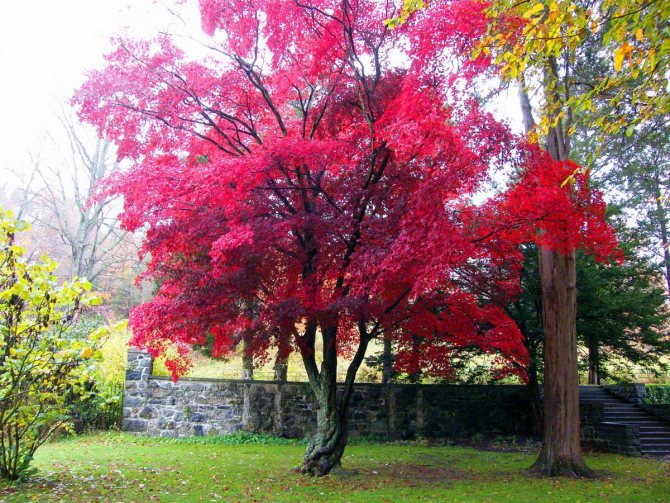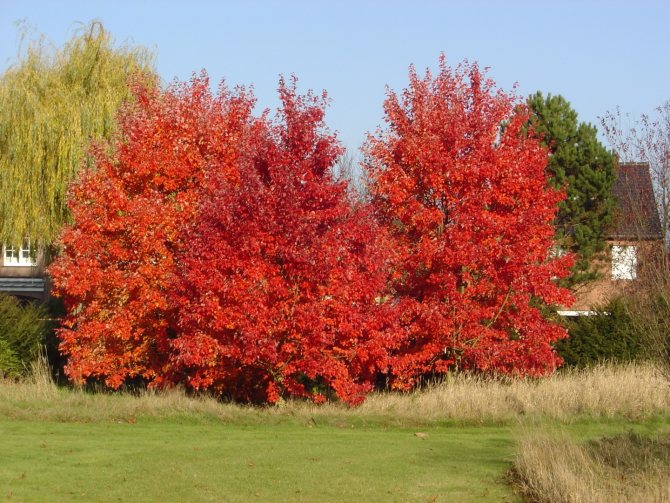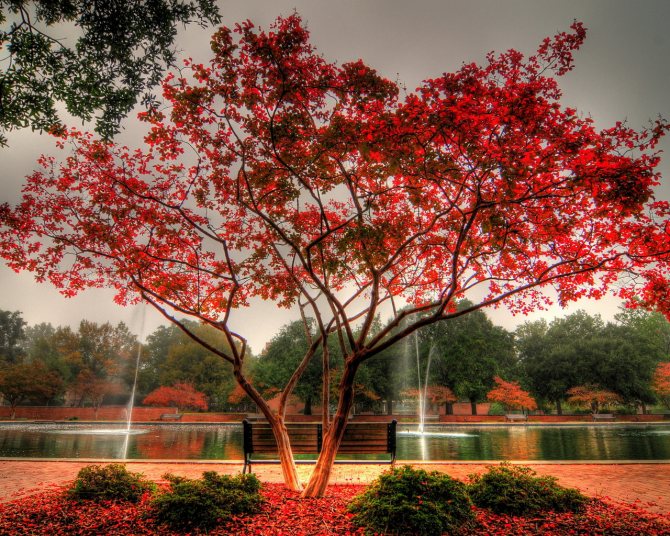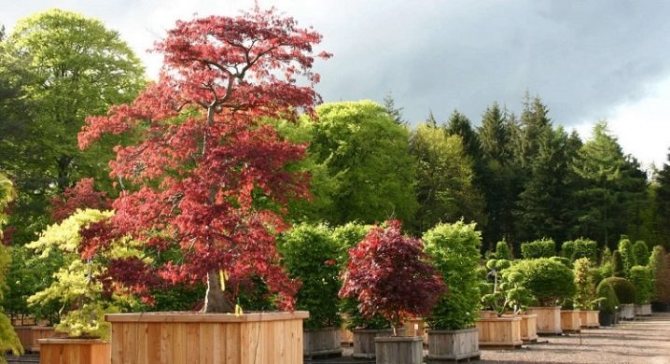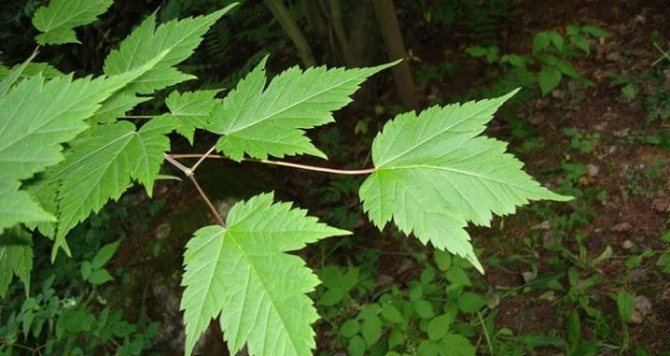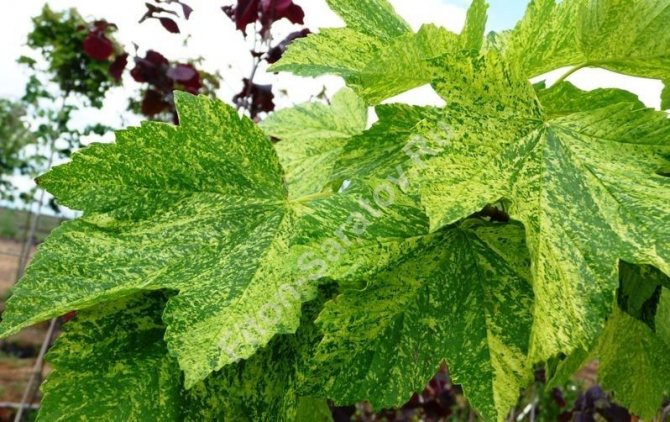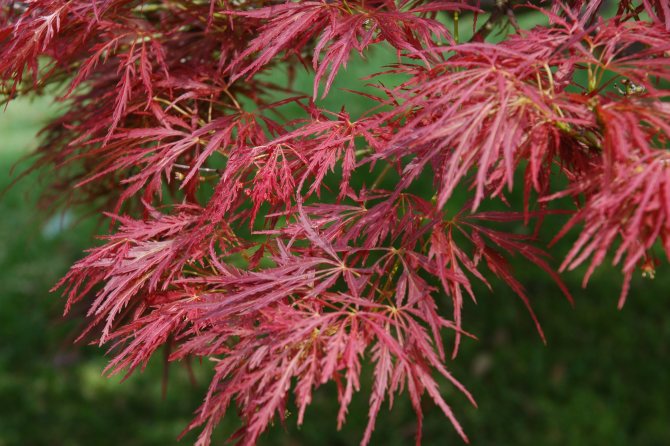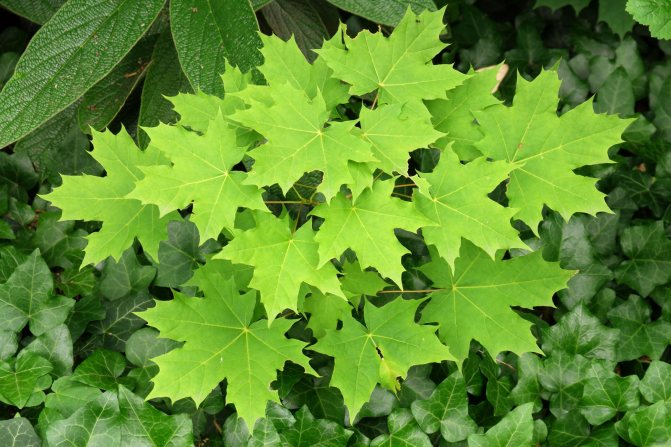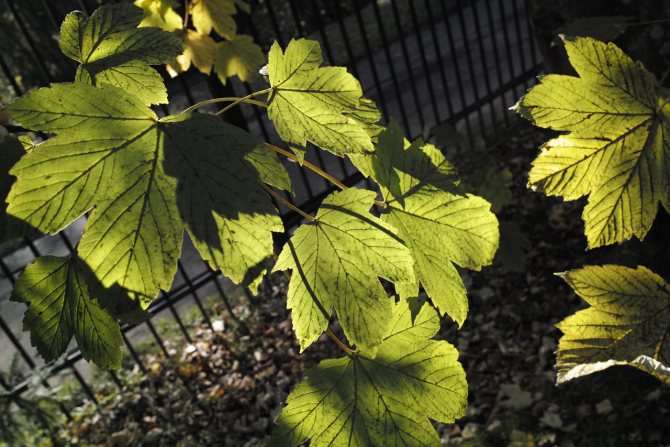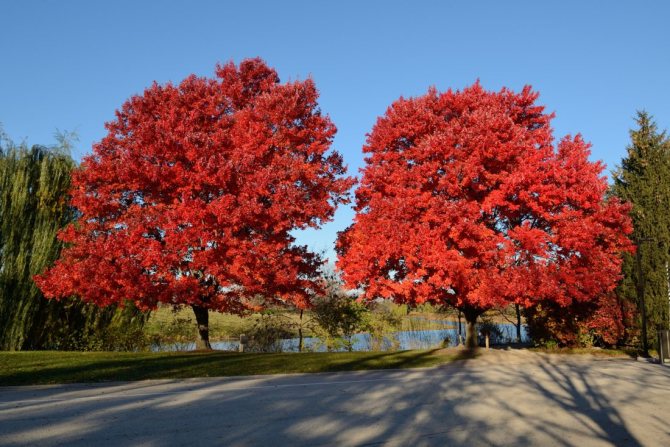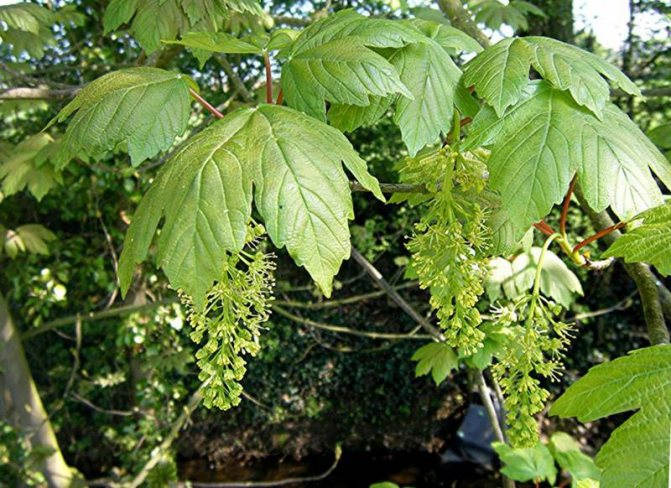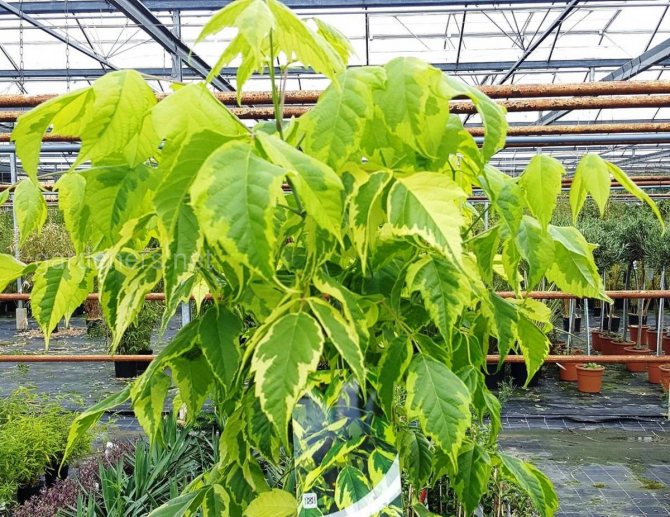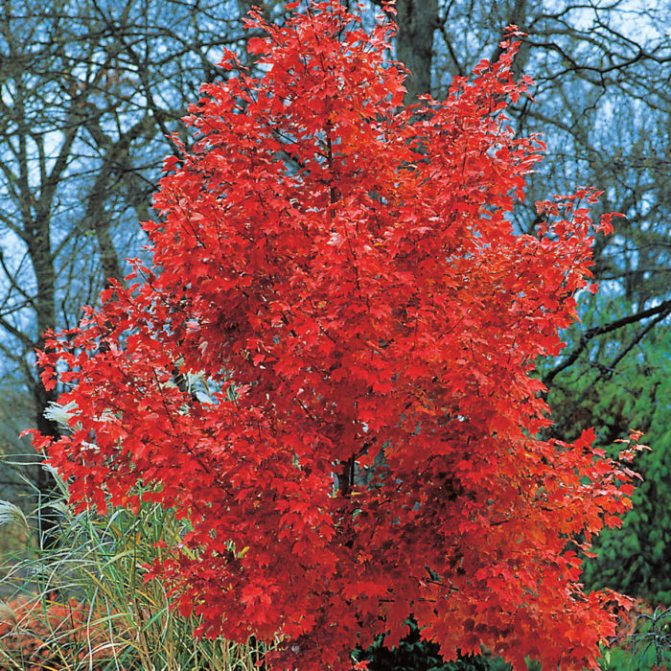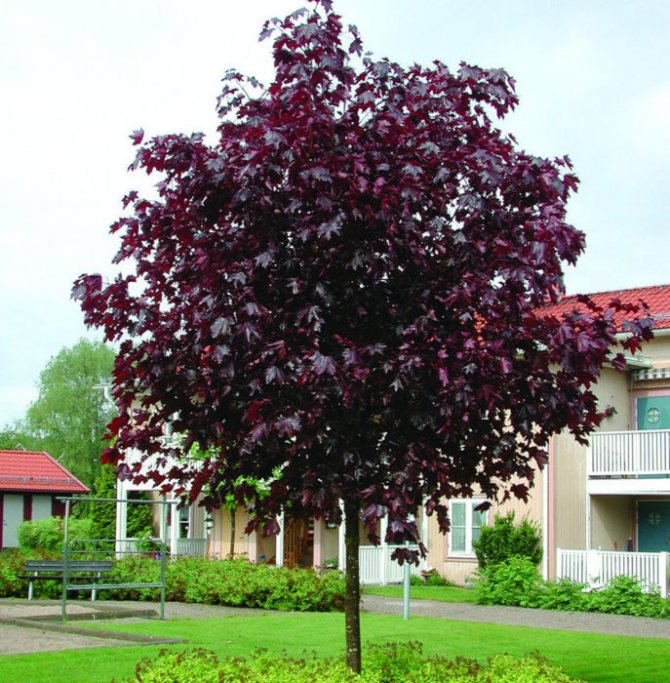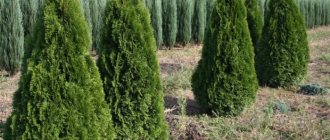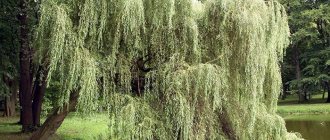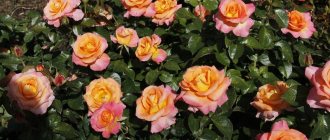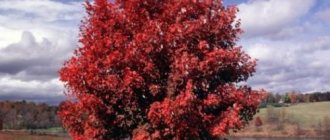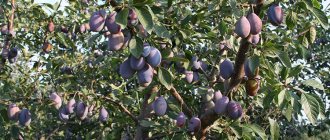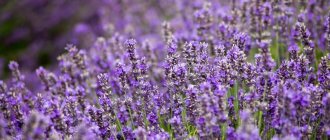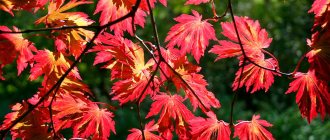Japanese maples are deciduous shrubs and trees that adorn gardens, patios, terraces and flower beds around the world. The red foliage looks attractive, the decorative type of plants with a purple, orange, maroon crown is appreciated by landscape design professionals and amateur gardeners. Japanese maple (red) is a challenge to the author of the boring phrase "green spaces". The unusual color of graceful leaves appeared as a result of natural processes and painstaking work of breeders.
What are you, maple?
There are many species of maples, about 160, and they all live in the northern hemisphere - in Europe, Asia and North America, more often in temperate climates. The only kind is laurel maple (Acer laurinum) settled in the tropics of the Southern Hemisphere.
This large genus of plants belongs to the Sapindaceae family. These are mainly trees with a height of 10 to 40 m, but there are also low shrubs - 5-10 m, with many shoots growing from the base. Most maples are deciduous, but there are evergreen species in the subtropics.
Maple leaves in autumn
What makes all maples different? Of course, their leaves are simple, large, palmate or lobed, sitting on long stalks - they adorn the tree, form a beautiful uniformly rounded crown. But not all types of maples have such leaves, in some they are complex-palmate, or trifoliate (for example, in gray maple, Manchurian, Maksimovich).
Still, all maples are easily recognizable by their fruit, lionfish or, as they are popularly called, "helicopter". Maple seeds have such special adaptations and, whirling in the wind, do not fall for a very long time and can fly off a considerable distance from the mother tree: this is how they spread, expand their range.
Three-bladed maple (Montpellier maple) with seeds
Interestingly, maples are such hermits, they usually grow alone or in small companies, but they hardly form large thickets or forests. Species that grow in the southern parts of the range prefer altitude: they can climb mountains up to 3000 m above sea level, it is in such places that maples grow in the Himalayas.
Maples in Russia
We have about 20 species of maples in Russia, 4 of them grow in the European part of the country (Norway maples, Tatar, white or pseudo-planan and field maples).
Flowering maple branch
Much more species grow in our Far East - small-leaved maples, riverside, pseudosibolds, yellow, green-barked, Manchurian, Japanese, bearded, Chonoski maple, palm-shaped. All our European species grow in the Caucasus, as well as the high-mountain maple, Monpelia, Colchis, Sosnovsky maple. One species - Japanese maple - is even listed in the Red Book of Russia.
Maple species
Of course, gardeners did not disregard such a wonderful tree: maple has long been used in landscaping, and breeders have bred many ornamental varieties. Let's take a closer look at some types and varieties of maples, the most decorative and used in horticulture.
Ash-leaved or American maple
Have ash-leaved maple (Acer negundo) leaves are complex-pinnate, consist of 3, 5, 7 and even 9 leaves; its crown is rather shapeless and shaggy.Probably, this species is well known to everyone - it is he who grows in our country almost everywhere, in cities even problems arise with him: multiplying by self-seeding and possessing rapid growth, it fills the space of streets, parks and squares and is considered almost a weed. This maple is native to North America, and on the territory of Eurasia, it formed a secondary range.
Ash-leaved maple branch with lionfish
It is the most frost-resistant of all types of maples, and therefore took root in the harsh Siberian conditions. This species is characterized by very rapid growth - during the season, the growth can reach 1.5 m.
By itself, this species is not very decorative, but it has garden forms with silvery or golden leaves, beautiful pubescence on the shoots, etc. For example, the 'Flamingo' variety - at a young age, its leaves are white-pink in color, and the tree looks very elegant and unusual; there is also a golden form of this variety.
Orchard decorative form of ash-leaved maple variegata
Ash-leaved maple, although it grows exorbitantly, is good if you need to quickly create a green array. It is also quite suitable for a hedge: with strong pruning, the tree quickly renews itself and gives many shoots, forming an impassable wall.
Norway maple or sycamore
One of the most common species in the European part of Russia - Norway maple (Acer platanoides). Its leaves are very similar in shape to sycamore leaves - hence the name. Not only the leaves, the whole tree is very beautiful: it has a straight and even trunk, a dense lush crown.
Plane maple leaves
Of course, breeders did not disregard such a tree and created many beautiful varieties on its basis. Basically, they differ in a variety of leaf colors - golden (‘Golden Globe’), purple (‘Krimson King’ and ‘Faassen’s Black’). 'Drummondii' has green leaves with a white border.
But the shape of the tree was also transformed - species with a spherical crown appeared. It is especially good in that the plant does not need to be formed - it keeps its shape all the time. There is a standard and columnar shape (‘Columnare’) - a tree up to 10 m high, acquires a more conical shape with age. The flowers have a pleasant smell and look very unusual.
There is a pseudo-plane maple (sycamore or plane tree, Acer pseudoplatanus). A remarkably beautiful tree - slender, tall (up to 25 m), with a neat rounded crown. The lower part of the leaf is lighter.
'Simon Louis Freres' maple leaf
Particularly interesting varieties: 'Brilliantissimum' - in spring its young leaves have a delicate pink-peach color, later they turn bronze-yellow. The varieties 'Leopoldii' and 'Simon Louis Freres' are variegated and short in stature, suitable for a small garden.
Manchurian maple
Maple Manchurian (Acer mandshuricum) is a very pretty tree, therefore it is loved by many gardeners. It has a beautiful, like a lacy crown, the leaves are trifoliate, complex, in the fall they are painted in bright orange-yellow-purple colors, and even the petioles of a bright red color. Loves open spaces.
Green maple
A beautiful tree or large shrub up to 15 m tall. Maple greenbore (Acer tegmentosum) is prized for the beauty of the trunks: its bark is smooth, green with longitudinal stripes. In young trees, they are white, like marble, with age - gray. Its spherical crown with dark cherry branches and large buds of a slightly pinkish color is also beautiful.
Maple green-bordered. Photo from the site perennialconnection.org
Wide large three-lobed leaves up to 16 cm long, thin leaf blades, dark green in summer and golden yellow in autumn. This maple is beautiful in the spring during flowering - its greenish-yellow flowers are collected in clusters up to 8 cm long, graceful and loose, and in the fall it becomes even more beautiful when its pinkish-brown lionfish fruits ripen and the foliage becomes bright yellow.The species is winter-hardy, fast-growing, rather unpretentious.
Maple red
This species can tolerate excessive moisture and even stagnant water, because in nature it grows in swampy areas in the eastern regions of North America, for which it is also called "swamp". Own name maple red (Acer rubrum) received for the amazing color of autumn leaves: the upper side becomes orange or purple-red, and the bottom becomes pinkish-silver. Its ‘Red Sunset’ is even brighter and more beautiful. There are also decorative forms - spherical and columnar.
Maple red
River maple or Ginnala
Low tree river maple (Ginnala, Acer ginnala) grows up to 5-6 m, you can form it in the form of a bush. The leaves have three-lobed, slightly elongated, fragrant flowers, slightly yellowish, collected in panicles. Lionfish fruit are bright red, which makes it especially decorative in autumn.
Red-leaved trees for large summer cottages
For central Russia, varieties are suitable Norway maple or plane tree (Acer platanoides):
- ‘Goldsworth purple‘- leaves reddish-purple, young - wrinkled;
- ‘Crimson king‘- the leaves are red-purple at first, then dark purple, the flowers are red-yellow.
Maple 'Goldsworth Purple'. Photo from the site rvroger.co.uk. Maple 'Crimson King'. Photo from arboretum.ie
At a young age (up to 10 years) they grow rapidly. Shade-tolerant, but only in an open sunny place does the beauty of the leaves become more vivid. Both are demanding on soil fertility and moisture. In hot and dry summers, watering is required. Propagated by grafting. The second variety is more winter-hardy.
The variety is interesting in its own way.Faassen's Black‘.
Maple 'Faassen's Black', appearance. Close-up of its leaves. Photo of the site
Reaches a height of 25 m; leaves are shiny, young - bronze-red, then - dark red, and the color remains throughout the growing season.
On a large lawn, a sculptural forest beech (Fagus sylvatica) 'Dawyck Purple' with a narrow crown and purple leaves.
'Dawyck Purple' beech. Photo from baumschule-horstmann.de. Shoots close-up.
It can be planted in a recreation area, creating a place of relaxation under a single tree. In the south, it reaches a height of 20 m and a width of 5 m, in central Russia it will grow much lower, it will freeze over.
Maple: description with photo, habit. Types and varieties of maple in landscape design
Ginnal's Maple (Acer Ginnala)
The Ginnala maple is a small deciduous tree or large shrub. It grows quickly, winter-hardy, photophilous, when planted in shaded places, it loses its decorative effect, it tolerates transplantation and city conditions well. Gives abundant growth. Prefers fertile soil. Photophilous. Frost resistant. Perfectly tolerates a haircut. An excellent ornamental plant, suitable for group and single plantings, creating bright, hedges, landscaping the banks of reservoirs, border plantings. Looks good in combination with a snowberry, dogwood, sucker, against the background of conifers.
| 5 years | 10 years | maximum | |
| Height, m | 1.00 | 2.50 | 6.00 |
| Crown diameter, m | 1.20 | 2.00 | 4.00 |
Palm-shaped maple (fan-shaped) (Acer palmatum)
The fan maple is a shrub or small tree with very graceful carved leaves. It grows slowly. Demanding on soil fertility. Photophilous. Demanding to moisten the soil and air. In frosty winters, it can freeze over without shelter. In terms of brightness and grace of leaves in spring and autumn, it can successfully compete with the most exquisite flowers. It is used in group and single plantings in protected corners of squares and parks, near paths.
| 5 years | 10 years | maximum | |
| Height, m | 0.75 | 1.60 | 5.00 |
| Crown diameter, m | 0.50 | 1.50 | 3.00 |
Palm-shaped maple Atropurpureum (Acer palmatum Atropurpureum)
The palm-shaped maple Atropurpureum is a bright large shrub or small tree. The leaves are initially bright red, later dark red. Slow growing. With age, it grows faster in width than in height.Demanding on soil fertility. Photophilous. Demanding to moisten the soil and air. In frosty winters, it can freeze over without shelter. It is used in group and single plantings in protected corners of squares and parks, near paths.
| 5 years | 10 years | maximum | |
| Height, m | 0.75 | 1.60 | 5.00 |
| Crown diameter, m | 0.50 | 1.50 | 3.00 |
Maple palm-shaped Bloodgood (Acer palmatum Bloodgood)
The Bludgood palm-tree maple is a shrub or a small tree of a very beautiful shape, up to 3-4 m high. It grows slowly. Requires fertile humus, sufficiently moist soils. Sun-loving, but tolerates partially shaded landing sites. Demanding on moisture. Average frost resistance. It is advisable to cover for the winter, especially young specimens. A very decorative variety for small gardens and container plantings.
| 5 years | 10 years | maximum | |
| Height, m | 0.60 | 1.30 | 4.00 |
| Crown diameter, m | 0.50 | 1.10 | 4.00 |
Maple palm-shaped Dissectum (Acer palmatum Dissectum)
Maple palmate Dissectum is a shrub with filigree, cut leaves. It grows slowly. Requires fertile humus, sufficiently moist soils. Sun-loving, but tolerates partially shaded landing sites. Demanding on moisture. Average frost resistance. It is advisable to cover for the winter. Looks great in group and single landings.
| 5 years | 10 years | maximum | |
| Height, m | 0.60 | 1.30 | 3.00 |
| Crown diameter, m | 0.60 | 1.30 | 3.00 |
Maple red (Acer rubrum)
Red maple is a large deciduous tree with a fast growth rate. It is not picky about soils, does not tolerate stagnant water. Possesses high frost resistance. It is decorative with a dense, strong crown, deep plumy foliage, large acorns, and autumn leaf color. Excellent in alleys plantings, as a tapeworm and in large decorative groups.
| 5 years | 10 years | maximum | |
| Height, m | 1.20 | 2.70 | 20.00 |
| Crown diameter, m | 0.80 | 1.80 | 7.00 |
Maple red Red Sunset (Acer rubrum Red Sunset)
Red Sunset Maple is a small, fast-growing tree with a conical, regular crown, which becomes more rounded and well-branched with age. Prefers moist soils, but grows on dry soils, does not tolerate compacted soils. Photophilous, frost-hardy. Suffering from the heat. It is impossible not to notice this plant in autumn, its foliage acquires a fiery color. It is used in single and alley plantings.
| 5 years | 10 years | maximum | |
| Height, m | 1.60 | 3.60 | 15.00 |
| Crown diameter, m | 1.00 | 2.30 | 7.00 |
Maple fake-plane diamondsimum (Acer pseudoplatanus Brilliantissimum)
The pseudo-plane maple Brilliantissimum is a medium-sized tree with a rounded-conical crown. It has a very decorative foliage: upon appearance - golden yellow, then light yellow with a pinkish tinge, and finally dark green in late summer and autumn. Refers to soil-improving breeds. It gives a lot of nectar, good honey plant. Prefers fertile, moderately moist soil. Does not tolerate salinization. Sun-loving. Young shoots can freeze slightly, but recover quickly. A valuable variety for urban plantings and small gardens.
top green with a yellow spot, bottom light green
| 5 years | 10 years | maximum | |
| Height, m | 1.00 | 1.80 | 6.50 |
| Crown diameter, m | 0.90 | 1.60 | 4.50 |
Norway maple (Acer platanoides)
Norway maple is the most widespread breed for landscape gardening in Russia. Large size, excellent dense crown, slender trunk, highly ornamental foliage are the most valuable qualities. It is quite picky about the fertility and moisture of the soil. Shade tolerant. Does not tolerate stagnant moisture and salinity. Winter-hardy. It is used in single and alley plantings, large decorative groups. The colorful autumn dress of Norway maple stands out in contrast against the background of conifers.
| 5 years | 10 years | maximum | |
| Height, m | 2.40 | 5.50 | 20.00 |
| Crown diameter, m | 1.60 | 3.60 | 15.00 |
Norway maple Deborah (Acer platanoides Deborah)
Norway Maple Deborah is a medium-sized tree with a dense rounded crown and bright spring reddish-purple leaves that change color in summer to bronze-green and turn yellow-orange or bronze in autumn.Photophilous, but grows well in partial shade. Drought-resistant. Does not tolerate stagnant water. Winter-hardy. In severe winters, young shoots can be damaged. Prefers fertile, well-drained soil. Good resistance to air pollution, so it grows well in urban environments. It is used for single and group plantings, creating alleys and tree and shrub groups.
| 5 years | 10 years | maximum | |
| Height, m | 1.20 | 2.70 | 18.00 |
| Crown diameter, m | 0.80 | 1.80 | 12.00 |
Drummondi Norway maple (Acer platanoides Drummondii)
Drummondi Norway maple has surprisingly delicate leaves bordered by a white, irregular stripe. Even in the shade, it illuminates and enlarges the space, making it airy and light. The growth rate is pretty fast. Photophilous. Shade-tolerant, but in shady places it loses its decorative effect. Drought-resistant. Winter-hardy, but in severe winters freezing of annual shoots is possible. Used as an ordinary, in groups, alleys. It tolerates urban conditions well.
bright green with white border
| 5 years | 10 years | maximum | |
| Height, m | 1.20 | 2.70 | 15.00 |
| Crown diameter, m | 0.80 | 1.80 | 9.00 |
Norway Maple Crimson Sentry (Acer platanoides Crimson Sentry)
The Crimson Sentry Norway Maple is a columnar tree with bright purple leaves that can be a true decoration of any garden. It is the most compact of all red maples. It is not picky about the soil, it can grow even on heavy clay, but prefers fertile, loose, moist enough. Photophilous, but can grow in partial shade. Does not tolerate stagnant moisture and salinity. Frost resistant. Ideal for creating bright and large spots in woody and shrub compositions.
Red-leaved trees for medium-sized summer cottages
For a medium-sized summer cottage, the following are suitable:
- Norway maple (Acer platanoides) 'Royal Red' - 6 m high and 5 m wide, leaves are bright red;
- 'Crimson Sentry' - 12 m high and 5 m wide, with a narrow vertical crown and red-violet leaves.
Maple 'Royal Red'. Photo from the site. Norway maple 'Crimson Sentry'.
They grow quickly, bloom, and are not capricious. Propagated by grafting.
In the southern regions appeared red-leaved catalpa Catalpa x erubescens 'Purpurea' - a sprawling tree 15 m high and wide, with broadly oval conical leaves 25-40 cm long, young - dark purple, later - dark green.
Red-leaved catalpa. Photo from the site.
Additional decoration - white flowers with yellow and purple spots, up to 5 cm in diameter, collected in clusters up to 30 cm long, and fruits - thin pods up to 40 cm long. Prefers semi-shady places with moist soil; young specimens may freeze slightly.
For medium and small dachas, especially in the southern arid regions, an unpretentious Gleditsia triacanthos ‘Rubylace’ - upright tree 10 m high.
Gleditsia three-prickly ‘Rubylace’, appearance. Close-up of her leaves. Photo from the site.
Its young dark bronze-red leaves are luxurious, which by the middle of summer become bronze-green.
You can choose seedlings of trees with red foliage in our catalog, which combines the offers of large garden online stores. View a selection of red-leaved trees.
Alphabetical index of plants
Examples of landscape projects of our studio
Landscape design and design services
The representation of a garden plot in three-dimensional display consists in the development of a 3D model of the garden, which does not yet exist, using computer modeling. 3D visualization is a necessary step in the landscape design process. It allows the customer to get a fairly accurate visual idea of how his updated, transformed site will look like even before the implementation of the landscape design project.
The history of vertical gardening in landscape design dates back to Ancient Egypt, when grapes were the first plant used for landscaping and landscaping gardens.Later, plants for vertical gardening came to Europe, where arbors, arches and pergolas entwined with vines and ivy began to appear, and from there to us in Russia, where such climbing plants as honeysuckle, climbing roses and maiden grapes found their place.
Maple that everyone knows.
The most common type of maple growing in our country is Norway maple (Acеr platanoides), - unlike many others, it is found not in mountain forests, but in lowland forests. Its appearance and characteristic leaves are well known to all people, even those far from dendrology. This tree is up to 30 m tall with an ovoid, loose tent-like dense crown.
The varietal variety of Norway maple is so great that, using only it, you can create interesting woody compositions. There are color forms, varieties with an altered growth shape and a leaf blade. Maples with unusual color of leaves look especially impressive, for example, purple, like in the varieties ‘Royal Red’, ‘Crimson King’, ‘Deborah’, ‘Schwedleri’, or with a white stripe along the edge of the leaf blade, like in ‘Drummondii’. Decorative forms ‘Columnare’ and ‘Globosum’ attract attention with crowns - columnar and spherical, which makes them a bright accent in the compositions. They are also good in solid and regular plantings.
Norway maple, or plane-leaved maple
Norway maple, or plane-leaved maple (Acer platanoides) - the most popular and recognizable type of maple, it was brought to Russia by Peter I. At first it was grown in the Summer Garden under careful care, as it was believed that it was not winter-hardy enough. Subsequently, it spread throughout the European part of the country, and now the growth of the Norway maple is getting rid of, like a weed.
It is a large massive tree growing up to 30 m in height with a dense crown. The leaves are five-lobed, up to 18 cm long. Their autumn color depends on how warm or cold, rainy or dry the past summer was. The color ranges from yellow to orange, sometimes purple. Small yellow flowers that appear on the plant in April-May, even before the leaves dissolve, are very decorative. They blend beautifully with the black bark of the tree.
Growing conditions: grows in any light. Wind-, dust-, smoke- and gas-resistant, suitable for city life. It grows best on moist, fertile loams with a high humus content and a slightly acidic or neutral reaction of the environment. Does not tolerate excessive moisture, acidity, overconsolidation and increased soil salinity. It is winter-hardy enough, however, decorative forms can freeze slightly and suffer from frost cracks in the trunk. Norway maple easily tolerates pruning. Even mature trees (up to 10-15 years old) can be transplanted.
Used in group and solo landings. Compositions consisting of varieties with permanent purple leaf color and varieties that change their color from green to red and vice versa look interesting.
Pay attention to the following varieties:
- Globosum is a tree 4 - 7 m in height with a round or spherical crown, usually cultivated on a trunk. This is one of the most popular varieties.
Maple species: tall and majestic
Among the maples, there are very large representatives. One of them - majestic maple, or velvety maple (Acer velutinum)growing in eastern Transcaucasia and the mountains of northern Iran. With a height of 50 m, it looks like a real giant, besides, its trunk diameter reaches 1.2 m. This maple looks especially impressive during fruiting, when it is decorated with large hanging fertile panicles carrying up to 60 lionfish. A truly magnificent sight.
Has a slightly smaller size pseudoplatanus maple, or sycamore (Acer pseudoplatanus), Is a typical representative of mountain forests in the southwestern part of Ukraine and the Caucasus. A tree up to 40 m in height and up to 2 m in diameter with a dark gray bark, peeling plates that expose a light young bark.Especially beautiful when free standing, forms a dense tent-shaped crown. In ornamental gardening, various forms of the pseudoplatan maple are most often used. The 'Purpurea' variety has a two-tone leaf color, dark green above and purple below. Young leaves of the 'Leopoldii' cultivar are covered with yellowish-pink spots, adults are variegated, with irregular, light green or cream spots.
North American is no less monumental silver maple (Acer saccharinum), reaching a height of 40 m with a trunk up to 1.5 m in diameter.
A characteristic feature of this species are deeply dissected five-lobed leaves on long petioles. Above they are light green, below - silvery-white, hence the specific name. In the autumn, this maple stands out with light yellow foliage. Looks great on the banks of reservoirs, in alley and group plantings, but it should be remembered that its branches often break off from adhered snow and strong gusts of wind. The decorative 'Wieri' variety is notable for its graceful carved foliage and a picturesque crown with long, drooping shoots.
Landing
To place a sycamore, it is advisable to choose light or slightly shaded areas, protected from the north wind, away from the walls of buildings and communications. A high level of groundwater, heavy clay soil is undesirable. The soil should be neutral, loose, well-drained.
Work is traditionally carried out in April or autumn, in September... The seedling holes are dug so deep that the root system is placed, and the neck remains 2-3 cm above the soil surface. If it is necessary to additionally equip the drainage, the pit is deepened by another 15–20 cm. The width should exceed the diameter of the roots by 2–3 times. Fine crushed stone, sand or stone chips are preliminarily poured at the bottom. For group plantings, the distance between the holes should be at least 2 m.
A mixture for filling holes is prepared from 50% peat, 30% sod land, 10% each sand and leaf humus... To it add 100 grams of nitroammofoska or any other complex mineral fertilizer. After the maples are planted, 20-30 liters of water are poured under the roots. When it is absorbed, the earth will settle slightly, the root collars will be at the surface level. After 2-3 days, it is advisable to pour an additional 2-3 cm layer of soil or peat into the trunks.

Far Eastern maples
It is believed that maples are the face of the Far East. There they live in the mountains and along the river valleys. In their appearance, they differ from European and North American species, which has recently been appreciated by landscape designers who use them very actively. In addition, the cultivation of most of the Far Eastern maples in central Russia does not present any particular problems, with the exception of some species. In the Central Russian landscape, they look like real exotics, which with their appearance are able to decorate any composition.
North American maple species
A large number of maples are native to the North American continent. Many of them settled in Russia long ago, acquiring a second homeland, and ash-leaved maple (Acer negundo) so naturalized in our open spaces that sometimes it behaves like a weed. Now it is difficult to imagine that this plant was previously grown in greenhouses as a valuable exotic. Currently, ash-leaved maple is widespread in culture. First of all, due to its rapid growth, frost resistance and undemanding soil conditions. However, its fragility and low decorative qualities force this species to be used as a temporary breed with others - slowly growing, but more decorative. There are a number of interesting color forms of this maple, which are widely used in landscaping:Aureovariegatum, Variegatum, Flamingo, Odessanum.
Growing through river valleys and swamps maple red (Acer rubrum) perfectly tolerates excessive moisture and stagnant water, moreover, it is not picky about soils.It received its specific name for the red female flowers and the orange-red color of the leaves in autumn. Its decorative forms - 'Red Sunset' and 'Scanlon' are characterized by a pyramidal crown shape and dark red leaves in autumn.
Very beautiful smooth green bark with white longitudinal stripes attracts attention Pennsylvanian maple (Acer pensylvanicum)... Its large, three-lobed leaves turn a rich yellow in autumn. The flowering and fruiting of this maple looks spectacular: the flowers, and then the fruits, are collected in long, hanging brushes.
Maple red
Red maple (Acer rubrum) is a tree that grows up to 15 - 20 m in height, with a massive, spreading crown. Even before the leaves appear, in March-April, whitish-red flowers bloom on the plant, flowering lasts 2 weeks. Then, large, three to five-lobed leaves with a red tint appear on the tree, which gradually turn green by summer. In autumn, the top of the leaf blade is colored orange-red, and the bottom is pinkish-silvery.
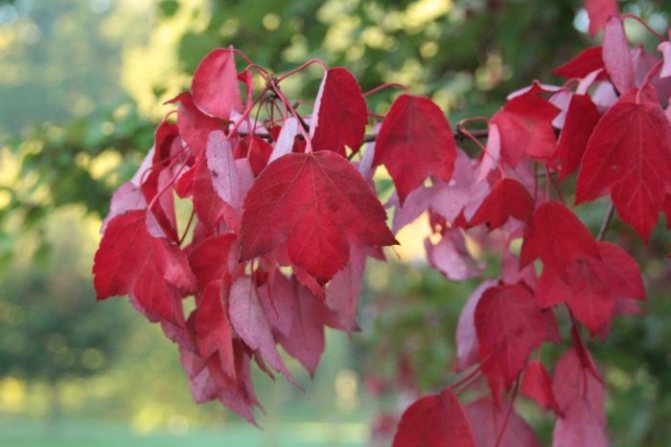

Growing conditions: red maple loves the sun, but is rather shade-tolerant. Wind-, dust-, smoke- and gas-resistant, can be grown in urban conditions. It grows best on wet, sandy, sandy or loamy soils with a slightly acidic reaction of the environment and a high humus content. Winter-hardy, tolerates waterlogging of the soil, but does not like alkalization and overconsolidation.
Picturesque both in a group and as a solitaire. On large territories, alleys are created from red maple.
Pay attention to these varieties:
- Columnare has a narrow pyramidal crown, its height is 15 - 18 m. In autumn, the leaves turn red-orange.
Shrub maples
Among the maple trees, there are also shrub species that fit well into small gardens.
They also perfectly tolerate a haircut, so they make very dense and spectacular hedges. These maples include - in addition to the aforementioned riverine maple and false-Siebold maple - also bearded maple, curled maple, Tatar maple.
Bearded maple (Acer barbinerve) very beautiful during flowering, in autumn it boasts dark yellow or orange leaves, and in winter its young shoots with purple-red bark stand out against the background of white snow. It is beautifully shaped and cut.
Very decorative throughout the growing season North American
Care rules
White maple needs a lot of moisture... In cool weather in spring and autumn, it should be additionally moistened once a month. In hot and dry summer - at least 1 time per week. Young seedlings need 15–20 liters of water, adult trees - about 10 liters. After watering, the soil must be loosened to a depth of 7–10 cm, and all weeds are removed.
If maples were planted in fertile soil, you can start fertilizing them from next year. Any organic matter is useful: rotted manure, peat, compost or humus. Top dressing is spread around the trunk 1-2 times a season. It is recommended to apply nitrogenous fertilizers in the spring.
For the winter, young sycamores need to be insulated... Before the start of frost, the root system is covered with a thick layer of leaves or spruce branches. The crowns are wrapped in burlap. From 5–6 years of age, trees adapt better to winter cold and no longer need additional protection. They need to be covered only in prolonged frosts below –20 ° C.
Maple trees need sanitary pruning every year... It is carried out in March, removing all frosty shoots. When shaping the crown, it is necessary to shorten or cut out entirely incorrectly growing and curved branches. You should also get rid of the root growth, which regularly appears in mature trees. If necessary, you can give the crowns the desired shape by pruning young shoots. However, sycamores rarely need this, as they are decorative and neat by nature.
Where else are maples used?
Many types of maple have valuable wood, which is used in the furniture industry, for the manufacture of sports equipment and musical instruments, in particular bows.
Maple sap contains quite a lot of sugar, especially in species native to North America, such as the sugar maple (Acer saccharum). In Canada, the juice of this maple is used to obtain maple sugar, and its leaf is the national symbol of the country. The stylized image of a carved sugar maple leaf flaunts on the jackets of Canadian hockey players and on the national flag of Canada.
Types of maples: photo and description
1 hornbeam maple (Acer carpinifolium) H = 10 m
A deciduous tree native to the mountain forests of Japan. The leaves are bright green, very similar to hornbeam leaves, yellowish-brown in autumn. Greenish-yellowish flowers appear simultaneously with leaf blooming. Relatively frost-hardy, in central Russia it grows with light shelter or in places well protected from the wind. This rare species will delight collectors.
2. River maple (Acer ginnala) H = 8m
A large shrub with a tent-shaped crown, grows along the banks of rivers and streams, hence the specific name. The leaves are three-lobed with an elongated middle lobe, dark green, shiny, in autumn - crimson-red. Flowers are yellowish, fragrant, collected in multi-flowered panicles, appear after full blooming of leaves. Grows quickly, winter-hardy, gives abundant growth.
3. Pseudosibold maple (Acer pseudosieboldianum) H = 8 m
A slender tree with a dense, tent-like crown. During flowering, large, yellowish-white flowers with purple sepals appear. Inflorescences racemose with pubescent axes. The leaves are bright green, rounded, finger-dissected to half of the leaf plate, in autumn they are painted in red-pink tones. Lionfish fruits are pinkish-red at the beginning of ripening, then yellowish-brown.
4 Manchurian maple (Acer mandshurirum) H = 20 m


Deciduous tree with a high, rounded, openwork crown. The leaves are graceful, trifoliate on long reddish petioles; in autumn they acquire purple-red tones. Inflorescences are yellowish-greenish, racemose, consisting of large flowers. Flowering is short, 10-12 days. It is an excellent honey plant. Poorly tolerates urban conditions and formative pruning.
5 fake maple (Acer pseudoplatanus) H = 40 m
A tall tree with a well-formed trunk, especially beautiful when free standing, forms a dense tent-shaped crown. The trunk is covered with ash-gray bark, peeling off in large plates. Against the background of blossoming leaves, narrow, multi-flowered inflorescences up to 16 cm long look impressive. Leaves 3-5-lobed, dark green above, below - glaucous or whitish.
6 Acer pensylvanirum H = 12 m
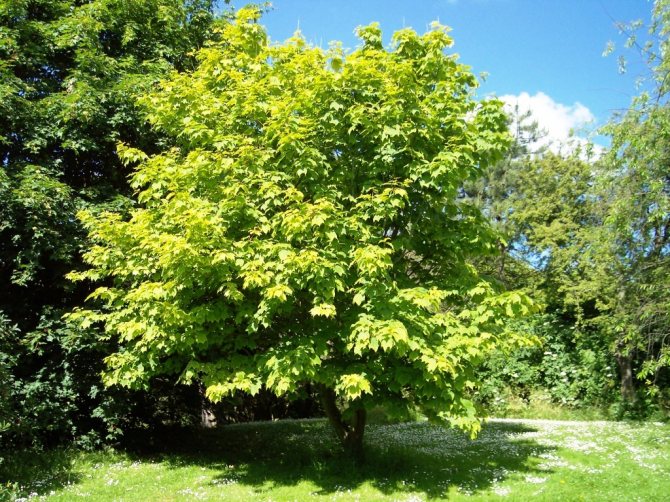

A tree with a dense crown, the trunk is covered with dark green bark with longitudinal light stripes. The leaves are large, obovate with three shallow lobes, in autumn they are painted in pure yellow tones. Yellowish flowers are collected in graceful drooping racemes up to 15 cm long. Flowering lasts 7-10 days. Fruits persist on plants for a long time. Outwardly, it is very similar to the green maple.


